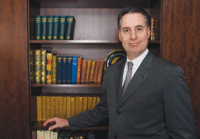Teaching corporate leaders to lead

A conversation with Training Solutions Inc. owner Michael Ferraro.
How do you coach a senior executive,who presumably has had a lotof experience managing people? A lot of our senior executiveclients will not attend a formalclass. They say they haven't the time,and they just won't go. So we doindividual 360 [degree] assessments,which evaluate an executive'smanagement skills based on a questionnairethat at least 12 colleaguesand company officials fill out. Theaccumulated report gives us a prettygood idea of what's happeningaround those client executives. We ... then come up with a personalizedcoaching program for them. How do you work with executives whodon't want to take the time to learn? We work with them once a month,sometimes twice, for a couple of hours eachtime, face to face in the office or outside oron the phone, so it becomes an ongoingrelationship. We give them homework andtechniques to try. Have you had to alter your instructionfor corporate executives when it comes toworking with federal contractors? There are some nuances in the[information technology] arena because ofthe work government contractors have to do.For example, some contractors require theiremployees to work at the customer's site, sothere is the issue of a virtual manager. In suchcases, performance management must bedone at a distance. Do senior-level executives exhibit certaincharacteristics not found at lower levels? A lot of senior managers are disorganized,and I'm not sure why that is. A lot ofthem are very reactionary ... instead of beingproactive and setting the agenda for what needsto get done. There are some senior executives Iwork with who start the week with 95 percent oftheir time already booked. You can't runyour business that way. I try to get them tomanage their schedule so that they don'tblock out all their time but instead leavetime open to handle emergencies. Weadvise them to schedule about 60 percentof their time with important things, andthen the other 40 percent should be managementby walking around [to] see what'sgoing on in the business. Isn't it harder for, say, the chief executiveof Lockheed Martin to walk aroundthan for the owner of a small company? Those guys walk around alittle more because they feel it's theirniche. But even then, when you get thecompany to a certain place andhire senior executives, thoseare the folks who don't walkaround. It may be someone else'scompany, but if you're the No. 2guy, you've got to get downthere, too. Employees need tobuild a relationship with you. What is your best advice? Build and sustain a good teamaround you and don't try to build it with abunch of yes-people. Bring in a diversemind-set and people who will challenge youat times.
 Michael Ferraro was a corporate trainer at Woodward and Lothrop when
Michael Ferraro was a corporate trainer at Woodward and Lothrop when
the Washington department store went out of business in 1995. He used the
opportunity to open his own company, Training Solutions Inc., in Chantilly,
Va., which teaches communications, sales, customer service and leadership
skills to front-line employees, supervisors and senior executives. Courses are
built around stress management, listening skills, performance management,
diversity training and team building. Ferraro recently spoke with Associate
Editor David Hubler.
Q:
Ferraro:
Q:
Ferraro:
Q:
Ferraro:
Q:
Ferraro:
Q:
Ferraro:
Q:
Ferraro:

the Washington department store went out of business in 1995. He used the
opportunity to open his own company, Training Solutions Inc., in Chantilly,
Va., which teaches communications, sales, customer service and leadership
skills to front-line employees, supervisors and senior executives. Courses are
built around stress management, listening skills, performance management,
diversity training and team building. Ferraro recently spoke with Associate
Editor David Hubler.
Q:
Ferraro:
Q:
Ferraro:
Q:
Ferraro:
Q:
Ferraro:
Q:
Ferraro:
Q:
Ferraro:
NEXT STORY: Picture this | A new green way